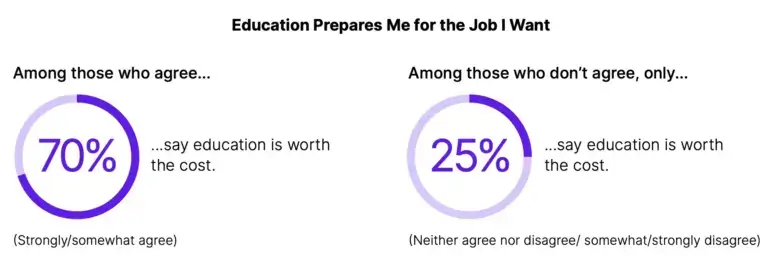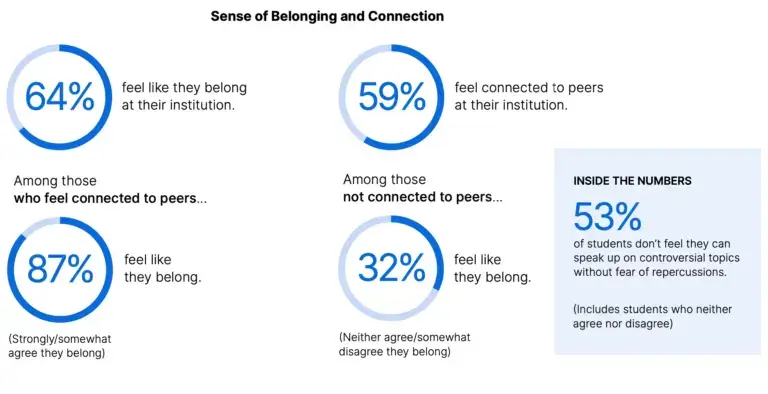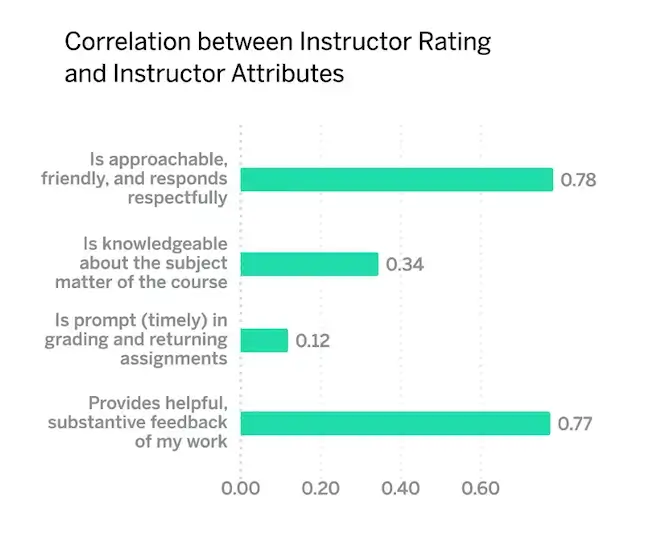Written by: Kaitlin Puga
Student retention is a top concern for colleges and universities. Students enter school – on campus or online – with a lot of expectations. Expectations about their classes and what they’ll learn, about their social lives and the people they’ll meet, about the challenges they’ll face and how they’ll succeed. When those expectations are not met, students are likely to leave.
What is student retention?
Put simply, student retention is the rate in which students return from one year to another.
This can be measured by tracking the number of students who enroll at the beginning of one school year to the number of students who enroll the following year.
Why do students leave their universities?
For a wide variety of reasons, college and university students leave without finishing their degree. Why is that?
Tuition, living costs, and student debt
For many, the price tag is simply too high and the education they’re receiving does not justify the cost. According to Forbes and College Board, more than 50% of students who graduated with a bachelor’s degree from a public or private college carried an average debt of $28,400 alongside their degree. Students are hyper conscious of financial aid, student debt, living expenses and possibly needing to balance a job alongside their education.
For some – it’s worth it. In a recent survey between College Pulse and Qualtrics, educational value is largely influenced by how prepared a student feels to enter the workforce – 70% say that education is worth the cost if education prepares them for the job they want. However, the number of students who claim a degree is simply not worth it is not insignificant.

Gen Z is not afraid of unemployment
Research shows that Gen Z are not as afraid of unemployment and career instability as previous generations. They crave work-life balance, mental health, and life experiences vs salaries, 401ks, and financial stability. In fact, a 2022 survey from the World Economic Forum reported that roughly half Gen Z workers stated they would quit their job if it had a negative impact on their work-life balance. This next generation of workers has a new set of priorities and it seems climbing the traditional corporate ladder is not worth personal expense.
Redefining the 9-5
A Microsoft study shows that Gen Z is trading in the traditional 9-5 corporate career for entrepreneurial endeavors. In fact, the study shows nearly half of the Gen Z population, about 48%, have numerous side hustles and multiple channels of income. Interestingly, according to Microsoft’s data, entrepreneurship is a top career choice with almost two-thirds of Gen Z Americans having started, or intend to start, their own business. Do students need traditional education for a non-traditional career?
How do you calculate student retention rates?
Student retention rates = # of students who enrolled this year or semester / # of students who enrolled the previous year or semester.
For example, you might have 10,000 freshmen during one given school year. The next year, you have 9,000 sophomores, showing a 90% student retention rate for sophomores.
Why is student retention important?
The primary goal of any higher education institution is to help students graduate and enter the workforce. Student retention is an important metric to measure that success. In addition, increasing student retention helps to provide an effective source of income for institutions through tuition revenue. At public institutions, state funding and institutional budget amounts are often tied to enrollment and retention numbers.
Free eBook: Your guide to experience management for education
What are drivers of student retention?
As we’re learning, many factors contribute to a student’s decision to stay or leave. By focusing effort on improving student engagement, student satisfaction, and student persistence; colleges are more likely to improve student retention overall.
1. Student Engagement
Many institutions have crafted their own definitions of student engagement. What engagement means for each student and each institution may vary to some degree, but they all have one thing in common: the focus on student engagement as a proxy for educational quality and a driver of student retention and student persistence.
Fun Fact:
In the 1980s, the National Institute of Education’s report Involvement in Learning defined two “fundamental principles about the conditions of educational excellence everywhere:”
- Student learning is directly proportional to the quality and quantity of student involvement; and
- The quality of any educational policy or practice is directly related to its capacity to increase student involvement.
- In the 1990s, Vince Tinto’s Leaving College synthesized wide-ranging research on college student attrition. He concluded that the more students are involved socially and intellectually, and the more frequently they connect with faculty and other students, the more they are likely to learn.
It turns out, student engagement’s correlation to student retention holds true for students of all ages. In K-12, engaged students are 2.5 times more likely to say that they get excellent grades and do well in school and 4.5 times more likely to be hopeful about the future than their actively disengaged peers (Gallup).
Gallup has been studying engagement for decades, having completed tens of millions of surveys and several meta-analyses, all finding that engagement is a measurement of how involved, enthusiastic and committed one is to an organization. For students, they say, the question is: “What is your psychological relationship with the school?” The challenge lies in the corollary question, “How do you know?”
One way institutions try to answer these questions is by measuring student satisfaction.
2. Student satisfaction
While student engagement focuses on student behaviors, student satisfaction focuses on the student’s perceptions and opinions about the quality of institutional services, facilities, and amenities.
A broad body of research shows that satisfaction breeds loyalty, and thus, student retention. Satisfied students are more loyal to your institution in appreciable ways: they are more likely to engage with alumni activities, more likely to maintain an ongoing relationship with their alma mater, and more likely to recommend your institution to others. A lack of satisfaction can certainly drive students away.
3. Student persistence
When thinking about persistence, it’s important for institutions to understand what motivates students to persist and what experiences they are looking for when they invest in your school.
According to Tinto’s theory of student departure, students need integration into formal (academic performance) and informal (faculty/staff interactions) academic systems and formal (extracurricular activities) and informal (peer-group interactions) social systems.
By taking the time to understand how student experiences shape a student’s motivation to persist, universities can figure out ways in which they can enhance that motivation, open doors and create a sense of belonging whether the students are on campus or online.
5 ways to address the student retention problem
At the end of the day, students enroll in institutions and universities because they want or need a good job.
Here are a few practical ways universities can better understand student experiences and improve student retention.
1. Keep a pulse on student satisfaction
Understanding student satisfaction can help you understand areas where your institution is meeting expectations or missing the mark for your students, which in turn affects student retention.
Measuring your students’ perception of their learning experience is important because it can greatly affect the holistic view of your institution. Students are paying for their education, and as consumers, they look to other consumers for guidance on the reliability and worthiness of the instruction you provide.
To collect student feedback, leading institutions administer both student and employee satisfaction surveys in an effort to understand the experiences their students’ have with their institutions. Prevailing wisdom advises regular, short pulses of student engagement and satisfaction provides a more complete perspective vs long surveys once or twice a year.
Fun Fact:
Since 1994, two-year and four-year institutions have used the Student Satisfaction Inventory (SSI) to identify students’ sense of the importance and satisfaction with a variety of experiences inside and outside the classroom including instruction from faculty members, academic advising, enrollment management, financial aid, campus life, campus resources, and others.
For more than twenty years, the National Survey on Student Engagement (NSSE) and the Community College Survey on Student Engagement (CCSSE) have asked students to identify the amount of time and effort they put into their studies and other educational activities. These surveys have students assess the ways their institution provides resources, organizes curricula, and encourages students to participate in a variety of activities that have been linked to student learning outcomes. NSSE is administered at four-year institutions; CCSSE is administered at two-year institutions.
2. Create opportunities for student engagement
Ask graduates what they remember from college, and you’ll hear about people—classmates, professors, coaches, and advisers. Connecting with peers and mentors is fundamental to the student experience and a student’s sense of belonging and purpose to their education. Student retention has a direct correlation with connection.
In a recent survey between College Pulse and Qualtrics, data showed that a sense of belonging increases with active learning and engagement. When asked what they’d change about the student experience if they were President of their university for a day, one student said “Have more opportunities for people from different backgrounds to interact with each other more.”
Beyond what they’re learning in the classroom, students crave community. 87% of students feel like they belong to an institution if their institution can connect students. If students feel like they would have to leave something or someone behind, they are less likely to leave.

3. Don’t underestimate the power of course evaluations
When it comes to student retention, course evaluations should not be overlooked. An anticipated, traditional form of student feedback and voice, course evaluations are an impactful way for you to gauge how a student feels about their academic work, providing another touchpoint when it comes to understanding student retention. In addition to helping faculty improve their classes, these evaluations help institutional leaders make budget and resource decisions.

Course evaluations have become an important student touchpoint, allowing you to more readily identify gaps in the learning experience and understand which actions have the biggest impact on experience, engagement, and performance.
Best practice is to evaluate every class, every semester with formative assessment mid-semester, as well as summative assessment at the end. But due to labor-intensive processes, universities and community colleges can only manage so many surveys for all of their classes, all of the time, so they have to default to some of their classes, some of the time.
Implement the right software to collect the right data all of the time, such as:
- The communication skills of the university, its departments, or its instructors
- The organization of the course or the institute
- The flexibility provided to students
- The assessment setup and its fairness
- The experience in the classroom
- The attitude of the teacher and the tone of teacher-student interactions
- How encouraged students felt during the course
- How in-depth the course covered the topic at hand
- How clear the teaching was for students
- How difficult the course was
- Whether students felt the course was priced fairly
4. Turn insights into action
In every case, institutional surveys are just snapshots of data that freeze-frame students’ perceptions of the university at a particular point in time. By stringing these snapshots together, institutions can measure aggregate institutional change over time.
Listen to your students. Understand what’s not working and why, then act. Take the right actions to close these experiential gaps and respond to the changing needs of your students.
5. Understand what students are saying with AI
In most cases, schools will turn to surveys to gather student sentiment or lean on student representatives who report back on what students are saying about their school experience. It’s tradition and an important part of student success and voice.
However, getting students to fill out a survey – on paper or online – is getting more and more difficult, especially with survey fatigue. All of a sudden response rates start dropping and the quality of your insights suffer as a result. To tackle this, more educational institutions are installing listening posts across physical and digital channels. Most recently, innovative schools are beginning to leverage AI to listen to their students and understand the mountains of unstructured data across their website, review sites, and social media — without more surveys.
How can Qualtrics help with student retention?
Major advances in technology allow institutions to boost their students understand with deeper, more actionable, real-time insights. To make better decisions and drive better student success, innovative schools combine both operational and experiential student data for immediacy, specificity, and actionability.
Enter XM® for Education, an integrated, enterprise platform with more than 125 channels you can use to listen to students, faculty, and staff. And of course, there’s a powerful, predictive intelligence engine under the hood working 24/7 to turn that into breakthrough insights.
At Qualtrics, we built the Experience Management Platform® to support students and enable higher education institutions to improve student retention.
The key is to go from insights to action, in order to move fast and close experience gaps as (or even before!) they emerge.
- Listen: Students are more than the cohorts they inhabit. Get to know every student individually with always-on listening tools.
- Understand: Eliminate the experience blindspots. Using all forms of experience data, XM for Education helps you understand the emotion, effort, and intent of what students are saying, whenever and wherever they’re saying it so you’ll know exactly what to do to design and improve student experiences.
- Act: Make taking action an automatic response, right across your entire institution.
Your guide to experience management for education